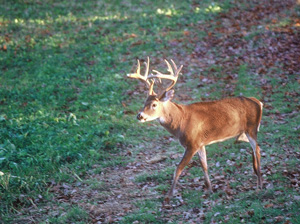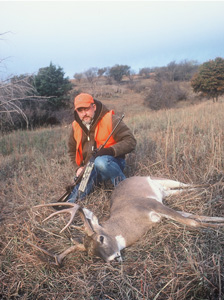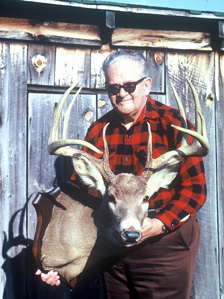
 Silently at first, then with the soft sounds of bird songs, daybreak slowly illuminated the dark West Virginia woods. Gray shapes came first, then a hint of orange on the eastern horizon.
Silently at first, then with the soft sounds of bird songs, daybreak slowly illuminated the dark West Virginia woods. Gray shapes came first, then a hint of orange on the eastern horizon.
A sharp frost held a grip on the land as I hunkered down in the stand and studied the slowly brightening forest around me. A squirrel scampered across the dry leaves. Soon the movement of a larger animal caught my eye. A deer was traveling just below on a bench paralleling the mountain ridge.
A quick look with binoculars revealed a fork horn. It was a good sign. A doe and fawn appeared next, moving slowly along towards bedding cover. Soon after them a larger animal came into view. If it was the deer that had made the rubs on wrist-sized saplings I'd seen on earlier scouting trips, I expected it to be a good one.
The binoculars showed that was indeed a fine buck. The mass was heavy, indicating an older deer. The tines were long. That was enough.
Carefully raising the .30-06, I aimed at the back edge of the buck's shoulder and squeezed. The rifle roared as the buck ran 30 yards and fell still in the dry November leaves.
The sun had yet to crest the eastern horizon. It was not quite 7 a.m. As sporadic shots echoed around me, I realized that other hunters, too, were taking full advantage of the first day of the firearms season.
Climbing down from the stand, I retrieved my prize, a heavy-bodied 9-pointer. The first day of the season had come through for me again. Like many hunters across the country, I've found that for putting a buck in your sights, no single day can compare with the first day of firearms hunting.
Opening day. Those are magical words for most hunters. And well they should be. From ritual and romance to pure practicality, no time in the woods is as special as the first day of the season.
From the youngster who can't sleep the night before to the old-timer who feels gratitude simply to be alive and hunting for another season, opening day is cherished like no other time of year. Whether it's a social affair involving lot of other friends or a solo trek into the woods, the dawn of a new hunting season is always special.
It's also immensely productive. No other period offers such a rich potential as the first day of firearms hunting. Deer haven't been pressured heavily and the rut is approaching. The sheer number of other hunters in the woods also helps keep the animals moving, increasing your chances for a buck.
Finally, plain arithmetic ups your odds. There are simply more deer in the woods before a large number of bucks are taken on the opener.
To increase both your chances for success and enjoyment of the first day of the gun season, I've found there are several important steps you should take ahead of time in planning, preparation and developing a sound hunting strategy.
Plan Ahead
 |
| There's no method that tops stand hunting on opening day. |
For starters, decide what hunting strategy you plan to use. I like to employ a variety of tactics throughout the season, from rattling to still hunting to drives, but for opening day, no method can match stand hunting.
It's not only the best way to bag a buck, it's also the best way to see the animals for a longer period and analyze their age and antler quality. I believe it's safer, too, particularly if you take a perch in an elevated stand.
Before the season arrives, double check to make sure your hunting territory is still owned by the same person and reconfirm that you still have permission to hunt it. Also make sure no major land use changes have occurred that could alter deer movement.
Scouting is a subject that I've previously covered in detail. Make sure you do plenty of it and take notes as you go.
Another pre-hunt step is to get all your gear organized and laid out, ready to go. Examine every item well ahead of time and repair or replace broken ones, upgrading equipment as needed. Organize what you'll need and have it set out the night before or stashed in your day pack or specific pockets, so you'll know where to find each piece of gear you might need quickly, such as scents, calls, knife, compass, GPS unit, flashlight, drag rope and enough food and drink to last the day.
Get everything ready so you can simply slip on your clothes, grab a quick breakfast and walk out the door whether you're in camp or at home.
Picking Your Spot
There are two main strategies for deciding where to set up on the first day. The one to use depends on the amount of hunting pressure your area receives.
If the location you're hunting has light pressure, the most effective and fulfilling way to hunt deer on the opener is to pattern them in advance of the season and waylay them on their natural routes of travel. This often means catching them moving from feed such as a food plot or crop field to thick bedding areas in the morning and the reverse in the afternoon. If the rut is coming in, watching funnels or corridors between doe bedding areas for traveling bucks or areas with active scrapes and rubs is the best bet.
This is my favorite approach for the opener and involves the fun of preseason scouting, interpreting sign, trying to predict deer movement patterns and taking a quarry unaware that it is being hunted.
The second approach is the one to turn to if pressure in the area you are hunting is heavy. The deer in this situation, especially the older bucks, are likely to know immediately that the season is open and try to escape.
 They'll head quickly for the most remote, cover-congested or swampy areas they can find. You need to find those spots ahead of the season and be there waiting. The strategy here is to use other hunters to your advantage so they help you by pushing bucks to the spot where you are waiting in ambush.
They'll head quickly for the most remote, cover-congested or swampy areas they can find. You need to find those spots ahead of the season and be there waiting. The strategy here is to use other hunters to your advantage so they help you by pushing bucks to the spot where you are waiting in ambush.
A deer is as intimate with his home range as we are with the inside of our homes. He knows the scents, other woods inhabitants and activity level, and he senses immediately when these things change with the opener. When large numbers of hunters arrive at parking areas, slam car doors shut, shout last minute meeting times to each other and stumble through the dry leaves with their flashlight beams glowing in the dark and their human scents wafting on the wind, bucks know what's going on.
At least the older ones do. They've seen it before and they know what to do. They head for steep hills, swamps and other remote areas, vacating open woods, fields and exposed edges. Finding cover where they can hide is the goal. One 5-year old buck in a Georgia study moved to a remote laurel thicket and stayed there the entire season.
Deer that don't flee immediately are subject to another more gradual push by hunters who get bored or cold and start to leave their stands after an hour or two. This can start as early as 9 a.m. and extends through 10 or 11 a.m.
Some hunters head back to camp for more coffee and a late breakfast. Others still hunt. In both cases the effect is the same: all three of the deer's major defense senses-sight, smell and hearing are alerted. This sends the animals that haven't already left fleeing for cover.
That cover isn't always in a remote area, but it must be thick enough that it allows the deer to feel they've found at least a temporary sanctuary to escape the commotion near the roads and parking areas. Study topo maps and aerial photographs before the season and you can often pinpoint rugged or dense cover and isolated spots that might be neglected by most hunters. Dense pine thickets, clear-cut areas growing back, swamps, steep ridges, brushy draws and pockets of greenbrier, laurel, multiflora rose, raspberries and blackberries are all potential escape locations.
Check these areas before the opener so you can pinpoint the best ones and the likely routes bucks will take to reach them. Then plan on being there well before first light waiting. You might have to circle in on a circuitous route to reach these spots without spooking the quarry yourself. That's why you need to allow plenty of time to get settled in before first light.
Wide pull-off areas and parking lots along roads are where most other hunters will start from. Incorporate this into your strategy. Let these other hunters "drive" the deer to you along terrain funnels as they head for escape cover that you've previously pinpointed.
 |
| Donald Houser bagged this 177 2/8 net buck on opening day in Augusta County, Virgina in 1963. |
Day of the Hunt
Another vital step is to be sure to allow extra time for this important day. On the opener, it's critical to be in your stand early. The best chance may come very quickly. You don't want to be stumbling into your hunting spot as first light arrives or fumbling around looking for cartridges or your flashlight on the most important day of the year.
It's also important to have enough time to hike in slowly and quietly, so you don't scare animals and don't sweat a lot. Carry your heaviest clothes and just wear a shirt and pants if you have a long hike in to the hunting location. Then cool down after the hike and then carefully add the extra heavy layers or put them on latter in the stand. Try to be in position at least 15 minutes before first light to let the woods settle down around you.
Line up several different options for where you'll hunt on the opener. Choose the best one at the last minute depending on wind, weather conditions, hunter activity and any final "hunches" you have.
Finally, bring enough food and drink and warm clothes that you can stay all day on stand unless physical limitations prevent it. Many hunters are up and moving from 11 a.m. to 2 p.m. leaving and then returning to their stands. This is a great time to nail a mature buck jumped up by one of those hunters.
Chances are the moving hunter will only see its white tail as it races away. But if you're on stand, warm, comfortable and watching alertly, you'll be ready for just such a chance.
That rich potential is what makes opening day such a magical time of year. It can happen at first light, or at high noon. Any minute of this best day of the year could produce the best buck of your life.
Make sure you're out there, watching and listening for the sound of hooves crunching on leaves or a snapping twig that could indicate a buck is traveling your way. I know I'll be out there with you.
- 10576 views

